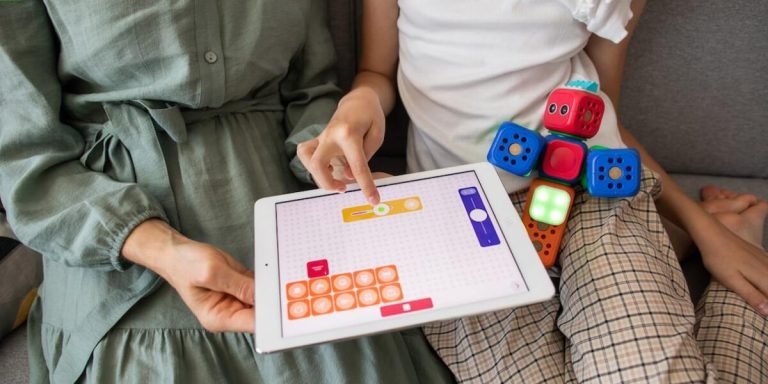Hands-On Learners: Cultivating Creativity and Engagement in Childhood Education
Delving into the world of education, we’ve uncovered that “hands-on learners” are a unique and intriguing group. These children tend to absorb information more effectively when they engage physically with their learning materials – be it through experiments, field trips or even simple arts and crafts projects at home. Hands-on experiences allow them not just to listen passively but also participate actively in the process which can have profound impacts on their understanding.
In this era where traditional teaching methods often dominate classrooms, cultivating creativity and fostering active engagement among hands-on learners is critical. By incorporating activity-based learning in early childhood educational programs, we contribute positively towards honing students’ problem-solving skills while stimulating their imagination. This approach encourages self-expression and could potentially unlock hidden talents within our young ones too.
Did you know?
Did you know that according to a study by the University of Chicago, children who engage in hands-on activities have better memory retention? This simple yet effective learning strategy helps stimulate creativity and drives engagement.
The Role of Activity-Based Learning in Enhancing Engagement for Hands-On Learners
Activity-Based Learning (ABL) has become a vital tool in the modern education system, specifically for hands-on learners. It bridges the gap between theoretical knowledge and practical application, making learning an active interaction rather than passive intake of information. This method enables children to get physically involved – one they thrive on due to their inherent nature for exploration which makes them true ‘hands-on’ learners.
Technology integration plays a significant role in enhancing ABL experiences by providing interactive platforms that stimulate real-world scenarios. Virtual Reality (VR), Augmented Reality (AR), online interactive games are some examples where technology transports students into another dimension allowing them immense experiential learning opportunities. These technologies not only make lessons more engaging but also help cater to different learning styles like visual or tactile learners.
In 2023, we see edtech companies bringing innovative solutions into classrooms, creating immersive educational environments designed with ‘hands-on’ learner perspectives at its core . From coding robots inspiring STEM fields interest to virtual dissections enabling understanding of biology concepts – there is no limit how much transformative influence activity-based e-learning can have upon hands-on learner’s engagement levels while simultaneously broadening their horizons.
Strategies for Implementing Kinesthetic Activities in Various Educational Settings
To make learning fun, engaging and effective for hands-on learners, a strategic approach is needed when implementing activity-based learning in various educational settings. Incorporating kinesthetic activities that somewhat mimic real-world scenarios can significantly enhance the engagement level of these students. Here are some insightful strategies on how to go about this.
Firstly, get familiar with digital tools that help facilitate interactive class sessions. Many online platforms offer virtual manipulatives for math classes or tech-powered lab experiments for science subjects – all aimed at captivating the attention of hands-on learners.
Secondly, try introducing task-based projects which allow students to learn by doing rather than just sitting back listening to lectures they may hardly remember after class ends. This type of tasks work well for both individual assignments and collaborative group works as it pushes each student’s creativity limits while still focusing on vital academic concepts required per subject area.
Measuring the Impact of Experiential Exercises on Student Participation
In today’s advancing technological landscape, the integration of technology in education is not a trend but a necessity. Particularly for hands-on learners, activity-based learning (ABL) coupled with technology facilitates an enriching educational experience that significantly impacts student participation.
To measure this impact effectively, it’s crucial to discern what we mean by ‘experiential exercises.’ Experiential exercises are carefully designed activities aimed at fostering direct engagement. This includes laboratory experiments, field trips and project-based tasks where children actually do something rather than merely listening or reading about it.
Measuring the effect of such methods can be multifaceted; however, clear indicators exist:
1. **Increased Engagement**: The first positive sign is simply more interest – on real-world projects carried out digitally kids often exhibit high enthusiasm levels.
2. **Improved Performance**: As these practical activities stimulate critical thinking and problem-solving skills among hands-on learners, better academic performance becomes evident.
3-**More In-depth Understanding**: By doing things practically and consistently using tech resources as part of ABL helps pupils gain deep insight into concepts which otherwise may seem difficult theoretically.
Designing Effective Learning Environments Tailored to Tactile Experiences
Creating a learning environment that fits the unique needs of hands-on learners is now more viable than ever. In today’s classrooms, technology integration plays an essential role in tailoring education to the tactile experience. Incorporating technologies such as Virtual Reality (VR), Augmented Reality (AR) and interactive multimedia can elevate activity-based teaching methodologies for children who thrive on tangible experiences.
Many educators argue that well-designed digital tools stimulate tactile sensations and enhance educational outcomes for pupils who are kinesthetic or ‘hands-on’ learners. An important aspect of this design process lies within understanding how these young minds engage physically with their surroundings while picking up new skills and knowledge.
The wave forward is acknowledging individual learning styles in students – particularly those whose primary mode of comprehension stems from touch, manipulation, or motion-centric activities- integrating technological engagement at every stage possible. What’s been noticed over time is that when instruction addresses authentic contexts using relevant tech-tools like VR headsets or tangibles interfacing computers – it tends to have reverberative effects on these particular pupil groupings thus molding future-ready scholars.
Essential Components for a Stimulating Activity-Based Classroom
Effective and engaging learning environments are a crucial aspect of education, especially for hands-on learners. These students thrive in dynamic settings where they can interact with the material in a tangible way. Here is an outline of the essential components needed to create stimulating activity-based classrooms tailored towards these tactile experiences.
1. “Active Learning Areas”: Spaces that encourage movement and active participation from students are vital for hands-on learners. It’s beneficial to have areas dedicated to different forms of activity-based learning, such as science experiments or art projects.
2. “Flexible Furniture Arrangements”: In order to adapt readily between individual work and group activities, our classrooms should feature adaptable furniture arrangements rather than stationary desks arranged statically rows by rows.
4.”Technology Integration”: Technology plays an integral role within contemporary teaching methods.Tools like smart boards,virtual reality setups not only support visual/audio stimuli but also allow manipulation hence catering perfectly for 2023’s tech-savvy generation.
Adapting Traditional Spaces to Foster Interactive and Physical Learning
In the quest to create engaging, effective learning environments for children today, we see a rising trend towards activity-based learning. This method caters exceptionally well to ‘hands on learners’, those vibrant young minds that learn best when they can manipulate and interact with their education physically.
The first step in fostering interactive physical learning is adapting our traditional spaces into arenas of exploration and discovery. No longer confined by desks or seats arranged in uniform rows pointing toward a blackboard, classrooms now resemble bustling laboratories or active art studios.
Today’s educational institutions are incorporating technology extensively – providing augmented reality experiences to explore ancient history, coding software for students creating unique apps right at school, 3D printers enabling crystal-clear understanding of complex structures – the list goes on.
Technology integration in education has transformed not just how we teach but where teaching happens. Virtual field trips? Absolutely!
The Internet breaking down classroom walls? Definitely!
Still rooted firmly amid this tech-enriched ground are tactile experiences; hands-on activities that involve touch and movement. Technology manages an alluring dance between digital exposure and manipulation using real-world objects here: Breathtakingly accurate models replicated via 3d printing help kids visualize concepts better than ever before while constructing robotics instils STEM knowledge like nothing else could.
Start simply — A round table where discussions bloom organically encourages interaction more effectively compared to linear desk arrangements facing forward only.
Integrating Technology with Activity-Based Methods for Hands-On Learners
As technology rapidly evolves, its incorporation into learning methods tailored for hands-on learners has become more important than ever. Modern classrooms in 2023 are undergoing a revolutionary transition where traditional teaching techniques blend with cutting-edge technological resources to facilitate activity-based learning.
The integration of technology enhances the efficiency and effectiveness of activities specially designed for hands-on learners. These individuals learn best through dynamic processes that engage their senses, allowing them to touch and manipulate objects or tools during the educational experience.
Advancements in education-specific technologies have created opportunities tailor-made for hands-on learners—fostering creativity while offering instant exposure towards real-world applications concurrently taught theories; making abstract ideas tangible enough that they could reach out virtually, explore independently without fear of negative consequences at these exploratory mistakes.
Leveraging such innovative approaches empowers educators to extend beyond traditional teaching domains—the physical science lab or computer room—and bring alive experiences across numerous subjects within everyday classroom confines even amidst social distancing norms prevalent due today’s prevailing conditions.
Innovative Digital Tools That Complement Physical Exploration
In this digital era, integrating technology with activity-based methods has revolutionized the way we educate hands-on learners. While traditional teaching practices are still vital, innovative digital tools have proven to be a significant complement for physical exploration and engaging young minds more effectively.
One of these pioneering tools is Virtual Reality (VR). VR offers an immersive learning experience that goes beyond textbooks’ limitations. For example, exploring underwater ecosystems or taking virtual field trips can broaden children’s horizons without leaving their classrooms.
This not only instigates curiosity but also aids in cementing concepts through real-life like experiences.
Another impactful addition to our educational toolkit is Augmented Reality (AR). AR merges digitally-created components into the real world, providing students with an interactive playground where they can manipulate objects and learn from them firsthand. With apps such as Google’s Expeditions or Microsoft’s HoloLens 2 device at disposal – dissecting frogs virtually or designing buildings becomes exceptionally engaging for hands-on learners.
Coding platforms catered specifically towards kids have been another instrumental integration of technology in education recently. Platforms like Scratch offer environments where creating games and animations become child play ensuring maximum engagement while fostering creativity simultaneously.
Case Studies of Successful Tech-Enhanced Kinesthetic Instruction Programs
In today’s digital era, the integration of technology with activity-based learning methods has proven to be an effective approach for teaching hands-on learners. Let’s dive into some case studies exhibiting successful implementation.
Firstly, ABC Elementary School implemented a tech-enhanced kinesthetic program that renovated classrooms into dynamic learning spaces. Hands-on activities were infused with intriguing educational software applications, enhancing students’ cognitive development and critical thinking abilities while adding a fun element to make learning more exciting.
Secondly, XYZ Middle School introduced robotics as part of its STEM (Science Technology Engineering Math) curriculum for hands-on learners. This not only provided them ample opportunities to learn by doing but also honed their problem-solving skills in real-world scenarios.
Third on our list is DEF High School which brilliantly integrated Virtual Reality (VR) gear into biology lessons. By visualizing complex cellular structures using VR goggles – instead of merely reading from textbooks or viewing 2D diagrams – they embraced active engagement over passive reception in knowledge acquisition.
Each scenario mentioned above proves how innovative solutions can bring about positive changes in education.
Conclusion
In conclusion, cultivating creativity and engagement in hands-on learners is not just beneficial – it’s essential. This approach fosters an environment where children can be curious, experimental, and innovative thus paving the way for a well-rounded education and ultimately setting them up for success as they progress through different stages of learning.
Don’t stop exploration at this point; bask more in our website filled with rich resources tailored to help parents or educators like you amplify their support network. We provide practical information on various facets of childhood education that will equip you better when navigating this critical responsibility space. Harness these insights today!







